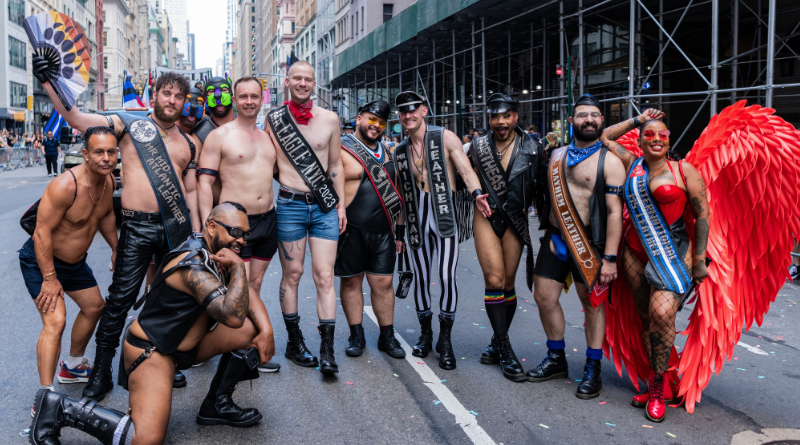
Bear Tracks: Leather Bears
“By its very nature,” Mark Thompson wrote in his 1991 landmark anthology, Leatherfolk,“S/M is a topic infused with ambiguity and contradiction. What appears to be one way on the surface is usually the opposite underneath.” The same might be said about the “incredible lightness” of being Bear. How did straight World War Two veterans on motorcycles beget gay leather bikers who begat gay daddies who begat bears who begat leather-daddy-muscle bears?
Sexologist Richard von Krafft-Ebing and Sigmund Freud classified sadism and masochism as pathological perversions. Krafft-Ebing coined the term “sadism,” drawing on the Marquis De Sade’s participation in and celebration of violent sex play. Krafft-Ebing also coined the term “masochism,” incorporating the name of Leopold von Sacher-Masoch, author of the 1870 S/M Urtext, the novella Venus in Furs.
Even with the American Psychiatric Association removing homosexuality itself from its list of mental illnesses in 1973, it’s been a struggle to redefine negative “takes” that damn BDSM as a perversion that makes players victims of their own twisted desires. Queer Enlightenment accepts today’s consensual S/M practices as safe, sane, and healthy sexual expressions between consenting adults. Leathersex scenes ideally begin with a discussion of interests and boundaries between partners prior to sex, setting a “safe word” to signal when a scene is beginning to go “too far.” The scene often concludes with afterglow, discussing the scene and continuing intimacy through cuddling, bathing, and eating. An additional safety strategy includes gathering in a dungeon play party where witnesses can monitor the revels. Geoff Mains’ pioneering 1984 Urban Aboriginals: A Celebration of Leathersexuality laid out the trust, intimacy, and ecstasy of leathersex practices.
Kinky sex (aka S/M, BDSM, leathersex) for men ritualizes power relations around masculinity, invocative appearance, and endurance made erotic through fetishes ranging from, to name but a few, verbal abuse, bondage, whipping, fisting, and fetish play in mindfuck scenes. Behind the psychology of dominance and submission there is a queer primal spirituality rooted in the pre-historic and intuitive “Old Religion of Gay Sex” that, like witchcraft and fairie, pre-dates the practices, rites, and fetishes of even the ancient Druids and all the “revealed” urban religions that later appeared in Jerusalem, Rome, and Mecca.


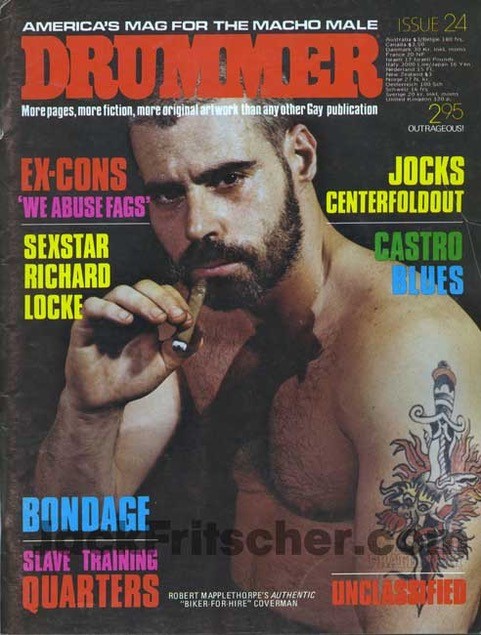
Drummer editor Jack Fritscher, who coined the word homomasculinity for his editorial in Drummer 24, 1978, wrote in his Introduction to the 25th anniversary edition of Larry Townsend’s The Leatherman’s Handbook, “The Greeks and Romans often made names pars pro toto where part of something stands for the whole–as in calling a man a ‘dick.’ So the word leather has come to symbolize more than its literal meaning, which is skin, toughened skin. Leather, as a concept, rises from the mists of pre-history, with archetypes of conquerors and captives, and memes of masters and slaves, in literal and existential tableaux of sublime power and human bondage.”
The leatherman and psychologist Guy Baldwin, who beefed up to become an IML winner and a Drummer cover man, also described in his 1993 book Ties That Bind that BDSM is a form of spirituality connecting it to other kinds of endurance rites, such as “practices of the Tantrics and the Shivaites and connect with the role of chastity in religious life, the rites of Dionysus and the rituals of other pagan religions.” His premise echoed Mark Thompson’s 1987 book, Gay Spirit: Myth and Meaning which Lambda Book Report listed as among “the 100 gay books that changed our lives.” Baldwin, who wrote for Drummer from 1986-1993, brought to mind how Drummer early on in issue 22, May 1978, had described coming out into leather as “a second coming out.” I would add that leather bears go through a “third coming out.”
Gay leather culture began in the US in the mid-1940s, growing out of the post-war biker culture which grew out of some veterans’ rejection of conformist mainstream American society. Straight outlaw bikers positioned themselves as marginal, oppositional rebels. It helps to recall that the pioneer leathermen who were in their late-twenties and thirties in the 1970s, while the Vietnam War raged, were born as 1930s and 1940s war babies who grew up imprinted by action men in uniform. Tom of Finland, who was 19 when the Nazis bombed Finland, said that enemy uniforms were his first turn-on and inspiration. Into these military roots, gay men stirred discipline, ritual, and style into their own lifestyle creating bike clubs of their own. In the 1953 film The Wild One, outlaw biker Marlon Brando is asked “What are you rebelling against?” He spits out, “Whatcha got?”
The Brando biker became an archetype– wearing jeans, t-shirt, and a Schott Perfecto 613 leather jacket, and a cloth biker cap. Gay men quickly embraced “The Look” from the foundational trilogy of Brando’s 1953 butch independence in Wild One, James Dean’s 1955 combustion-engine attitude in Rebel Without a Cause, and Kenneth Anger‘s 1963 blasphemous gay biker film Scorpio Rising. Anger’s experimental short film raised the hackles of both the American Nazi Party and the Lutheran Church—no mean feat.
Watching leathermen subscribers aging out of the Hollywood leading man ideal and, growing heavier and hairier in the process, Drummer began making a sexy fetish of maturing secondary sex characteristics of body hair, beards, weight, and muscle mass. Building on leathermen, Drummer editors added their first daddy bear in 1978, placing a Mapplethorpe bear on the cover. This evolution of generic leather into a furry fetish was a huge surprise because it disrupted the stereotyped gay and straight prejudice that all gay men are effeminate.
By the mid-1970s Drummer had become a kind of international “Leather Bible” teaching leather to old hands and new. It became “Son” of Larry Townsend’s Leatherman’s Handbook, the first “how to” guide ushering leather out of the closet on a motorcycle. I read it in 1976 when I was coming out in West Germany. I immediately went to Munich where the nearest leather subculture existed. I met my first master there–I was what is now called a “twink” (with a swimmer’s build and chest hairs just beginning to sprout) and my master was what would today be called a “leather muscle bear.”
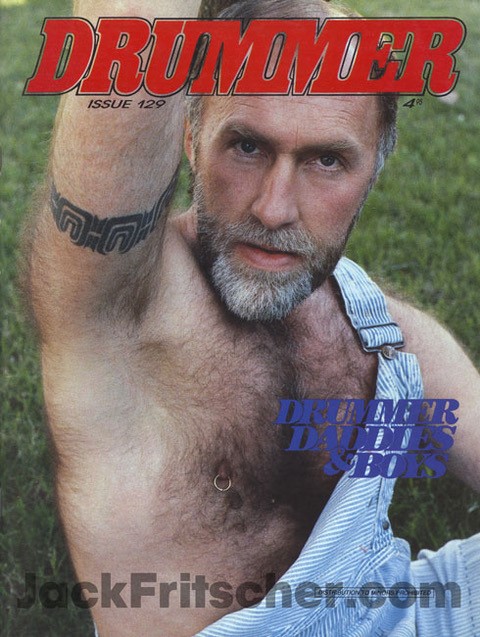

In my first two “Bear Tracks” columns, I addressed the “murky origins” of bears trying to figure out the DNA of the “Bear Origin Story.” (Where did bears begin? San Francisco? Elsewhere? Who was the first self-identifying bear? Did The Advocate or Drummer invent the gay bear?) Questions about the first leather club, leather bar, and whether there were official early protocols also remain murky. Among the earliest biker clubs were the Satyrs (Los Angeles,1954), the Oedipus Motorcycle Club (Los Angeles, 1958), the New York Motorbike Club (New York City, 1958), as well as the Warlocks and California Motor Club (San Francisco) and the South Pacific Motor Club.
Because leather attitude and fashion needed a runway and sashes, leather bars, such as the Mineshaft in 1976, became performance spaces of kink. In his Handbook (1972)Larry Townsend testified he had come out in 1955 Los Angeles in the (perhaps first recorded leather bar) “Cinema,” calling it the platonic ideal of “what a leather bar should be.” Gay leather bars soon followed. Some of the earliest (1950s) were in New York City and in California. Los Angelenos take pride in being home to the beginning of so much of gay culture, including their city’s role in the leather scene. Its history is often forgotten, eclipsed by San Francisco. Several early leather bars opened and closed in the 1950s in New York. The police often shut them down and they would simply open in another location. These bars preceded the Gold Coast in Chicago (1958), which is frequently cited, erroneously, as the first leather bar. To complicate matters further, there is the question of how to define a leather bar. The Atlantic House (“A-House”) in Provincetown, currently considered by many a leather bar, was built in 1798. At some point it gained popularity with gay men and began attracting leathermen.
In 1962 in San Francisco, Folsom Street pioneer Tony Tavarossi opened his kinky leather bar the YNOT (Why Not) an anadrome of “Tony,” in the Tenderloin District North of Market while South of Market, two leathermen from LA aided by Drummer artist Chuck Arnett opened the Tool Box that was so rebellious, homomasculine, and iconic that Life magazine featured it in its June 26, 1964, issue, five years before Stonewall. One can also consider “hybrid bars” like the Atlantic House, built in Provincetown in 1798, as possibly the oldest gay bar in the US with its latter-day “Macho Bar” on the second floor now a leather bar. In San Francisco, the first proto-bear bars were the Ambush (1973), Bear Hollow (1979), the Pilsner Inn (1980) which in February 1987 hosted the first Bear Contest, and the Lonestar (1989) with its biker-bear-cigar-driven Rainbow Motorcycle Club founded in 1971 at the No Name bar on Folsom Street.
That Life 1964 story “Homosexuality in America” featured a two-page spread of Chuck Arnett’s huge Lascaux mural on the Tool Box bar cement wall depicting ominous shadows of archetypal leathermen. The national photo coverage was a watershed moment uncloseting the leather mystique because a camera — back in the day before attitudes changed with the advent of cell phones — could instantly empty a gay bar. Calling San Francisco the “gay capital of America,” years before William Carney’s The Real Thing (1968) and Carl Wittman’s Gay Manifesto (1971), Life magazine like the Pied Piper led the national mass migration of post-beat and post-hippie leathermen to San Francisco because the feature article written by Paul Welch became a beacon drawing gay men to join the South of Market leather habitat. By the 1970s, leather clubs had spread to Australia, West Germany, London, Amsterdam, and elsewhere.
In 1980, Cruising, William Friedkin’s film about leather murders, renewed the gay mainstream prejudice and fear of leather driven by The Village Voice and The Advocate. Here’s Fritscher’s summation of what Mineshaft manager Wally Wallace and he discussed about Cruising in a 1990 video interview for Drummer. “Without reading the Cruising screenplay which means without using critical thinking, the gay mob in the streets driven by the hysterical Arthur Bell, desperately seeking their own ‘Stonewall Moment’ ten years after the original Stonewall they missed, rose up like a lynch mob against the film crew for portraying leathermen as “murderers.” Which was not true. Actually, they weren’t protesting the film as much as they were targeting gay masculinity, particularly the assertive homomasculinity of bikers and bears whom the reactionaries could not abide, likely because of their hate of men they preached had bullied them from boyhood. It would have been better if those boys in that band had risen up ten years earlier when Friedkin portrayed gay men as monster stereotypes in his film The Boys in the Band. Wally refused to let Friedkin shoot in the Mineshaft not because of the script, but because of the dirt done him by the crew of Cruising who had him arrested by the NYPD so the set decorator could go sneak into the Mineshaft and shoot photos of the interior while Wally was in custody for the afternoon. Using those pictures, the bar scenes were shot to look like the Mineshaft in the space of the after-hours Hellfire Club in the basement of the Little Triangle Building at 14th Street and Ninth Avenue. Laughing off the protests, hundreds of local leathermen happily appeared as extras in the now documentary-like leather bar scenes. Unlike the politically correct protestors who set out to censor us, the film itself did no harm to leather culture. It flopped at the box office, just before AIDS, because it wasn’t a very good movie.”
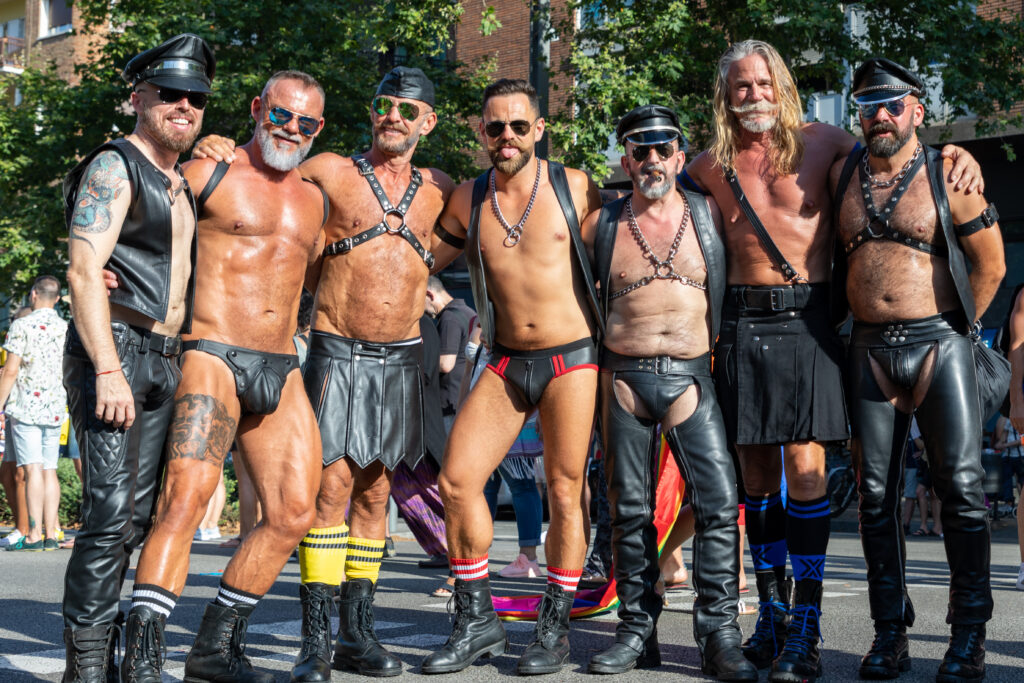
After the bars, came the bespoke leather shops. The long-running “Leatherman NYC” opened on Christopher Street in 1965. In 1969, Leather’n’Things clothiers opened in San Francisco with its handsome catalog featuring the richly upholstered Colt model Ledermeister (Paul Gerrior 1933-2021), arguably the First Bear, an archetypal twin of hairy TV-star Clint Walker. That hot catalog collected by every sex tourist who came to Castro Street stayed in print until the store closed around 1974. That same year, Rob Meijer, the first great leather designer, opened RoB Amsterdam Shop, the first leather shop in the Netherlands. It should be noted that attitudes toward leather in Europe differ from American attitudes. In the US, leather is a lifestyle, and kinksters may or may not wear leather. Europeans take a much less regimented approach and it is common for non-kinky men to wear rock-and-roll leather pants and jackets. Leather has long been a popular (non-gay) fashion in Germany. Rob of Amsterdam:
I have witnessed the inflationary cost increases of leather as commodity fetish in the queer leather community from 75-cent brass cock rings and alligator tit clamps sold in hardware stores to thousand-dollar leather jackets. Sociologist and economist Thorstein Veblen wrote about the “status anxiety” felt by those who fear not belonging to “the right social class.” A personal identity is established by buying and using “stuff” (goods and services) that communicates the “correct signals” of social belonging and prestige. In the leather community this has been expressed by some through the conspicuous consumption of leather accoutrements and body modifications: piercings, tattoos, steroids, and gym-toned bodies. In other words, some players have foregone sexual fetish and ritual in favor of displaying their social and economic privilege—demonstrating how much leather they can afford to buy, how many leather events they can afford to attend (similar to gay circuit parties), how expensive getting their tattoos was, how sexually attractive they can make themselves, and the like. A similar shift to conspicuous consumption also emerged among some in the bear community. This trend caused me to leave, temporarily, first the leather community and later the bear community. I was shocked to discover I had become too poor to be a leather kinkster or a bear. In a future column I will address socioeconomic class in the bear community.
The nascent bear culture of the 1980s offered an alternative for middle-aged gay men whose only option to remain viable in the bar scene was the leather world in which body-shaping fashion enhancements can add ten years to a man’s sex life. Nowadays, thanks to the welcoming arms of the bear community, some gay men come out simultaneously as leather bears. As the bear community continues to grow and evolve, mama bears and leather transbears have created a home for themselves. For another perspective, listen to the Secular Sexuality (Austin, TX) interview by two mama bears with Daddy Danger (she/her), a self-described “lady leather bear”.
Bear identity itself emerged as a response to ageist, looksist, fat-phobic, and other discriminatory practices in the gay white male community. As the bear community continues to evolve and expand, increasing numbers of bears of color and mama bears are gradually gaining wider acceptance. Racism and misogyny have long existed among some in the gay white male community. The recent public visibility of gay transmen has been met with transphobia. The leather and bear sexual outsider communities have been confronted over this contradiction between their stated commitment to inclusivity and their sometimes discriminatory practices, which continue to this day.
In December 2023 Ali Mushtaq wrote of his experiences of being discriminated against in both leather and bear venues. He also notes another leather event where an entertainer employed racist stereotyping as the basis for their comedy. In response, ONYX, the Leathermen of Color organization, issued a series of demands to rectify this issue. One commonly practiced strategy to change social injustices is to seek legal and financial reform. This has been part of the path by which gay/queer organizations have achieved a remarkable degree of legal protection and social acceptance. However, with the current political situation in the US, “broad acceptance” seems overly optimistic.
Ali Lopez, one of the best known and well-loved leather bears, won Mr. International Daddy Bear in 2006 at IBR. He is currently Mr. International Leather Bear. He has done service– fundraising for charities, such as hurricane survivors in New Orleans and Puerto Rico, serving as an ambassador of the leather and bear communities to the broader queer community, and, most significantly, being as visible as possible to represent black and Latino bears. Ali is Afro-Caribbean–black and Puerto Rican. When he first came out and wanted to join a bear club in the Baltimore-DC area, he was told, “Oh, you might not fit in.” His first impulse was to walk away from this “polite” form of racism. Upon further reflection, Ali decided to join the club and “be the most visible person that the club has.” Through his approach he has embodied the bear ideal of inclusiveness, heightened awareness in the bear and leather communities, and promoted understanding and good will throughout the queer community.
Bears, Bikers & Mayhem (Gettysburg, PA) is the first large event combining bears, leather, fetish motorcycle, and puppy communities. Numerous bear and leather clubs now hold leather bear contests. There is a Facebook group called Leather Bears International, which runs a fundraising contest. The German-language online magazine BOX covers bear, leather, and leather bear events in Europe. And, of course, Bear World Magazine reports on bear and leather bear events worldwide.
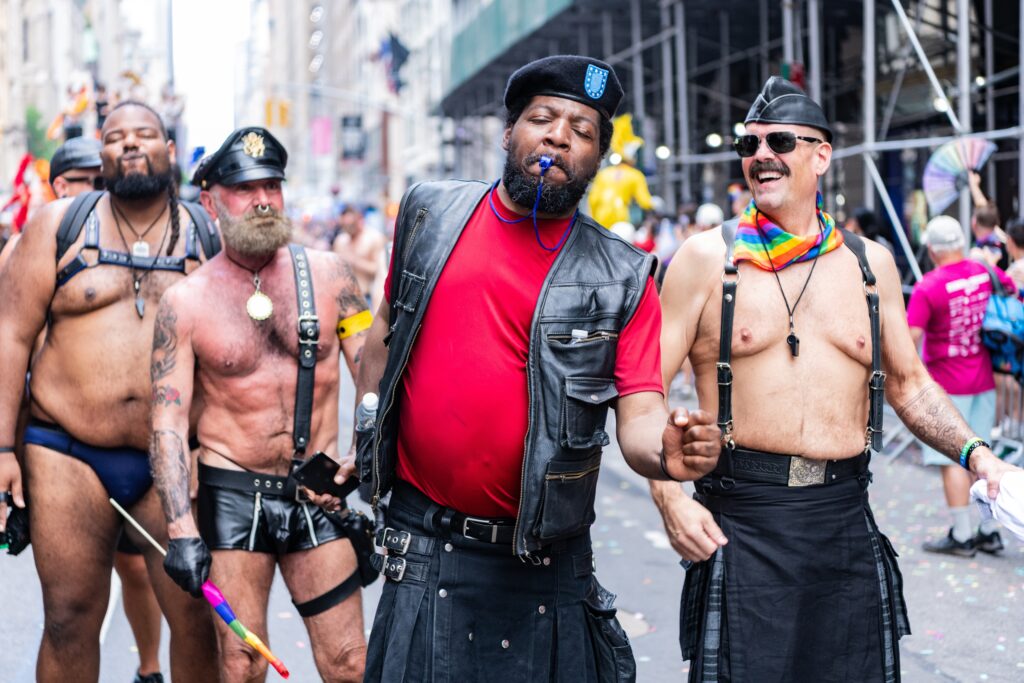
The Leather Archives & Museum in Chicago (founded by Chuck Renslow and Drummer publisher Tony Deblase in 1991) is committed to “making leather, kink, and fetish accessible through research, preservation, education, and community engagement.” Its collecting and archiving of bear history has recently been expanded by becoming the permanent repository for the Bear History Project International. The UK Leather and Fetish Archive in London was founded in 2016 and is part of the Bishopsgate Institute.
In recent times leather has also become a fashion statement in the broader queer community, its practitioners often unaware of its history. As such, leather has become a cliché, detached from its historical roots. The controversial term “old guard” is applied to refer to the values and practices that emerged in the 1950s and 1960s, such as exercising military discipline, mentoring newcomers, and respecting leather for its ritual significance, where bestowing a piece of leather is a rite of passage. “Old guard” has become problematized, meaning different things to different generations. The debate is over facts, myths, and individual memories. A flashpoint of the controversy is John D. Weal’s 2010 The Leatherman’s Protocol Handbook: A Handbook on “Old Guard” Rituals, Traditions and Protocols. Historian Jacques Barzun wrote that “there is nothing personal about facts, but there is about choosing and grouping them. It is by the patterning and the meanings ascribed that the vision is conveyed … Linking is particularly important in cultural history, because culture is a web of many strands; none is spun by itself, nor is any cut off at a fixed date like wars and regimes.”
Having evolved from its roots framing it as a psychopathology and into a healthy expression of gay sexual practices, kink has become respectable enough to become an area for academic study in universities. Bears, however, remain an understudied culture. Today the leather bear expresses a double homomasculinity, embracing the masculinity of both leather and of body hair. Bears continue to manifest the gentle nurturing qualities of the species. This is also true of leatherfolk, as Geoff Mains celebrated in his novel Gentle Warriors.
A notable portion of today’s queer community has become aggressively hostile toward the worship and idealization of traditional masculinity, conflating heteronormative hypermasculinity with homomasculinity which invokes the best that males can do. Despite the increasing acceptance of queers and queer culture in mainstream society, leather bear masculinity has become a flashpoint for the emerging strategy of “queering” masculinity, studied only for how we “perform” our paradoxical “hybrid masculinity.” But wait! There’s more! Leather bears are also “queering” gay masculinities in ways only now emerging and moving in directions opposite to those of the academically privileged. Our proud identity has been incorporated in the Leather Bear Flag recently designed by Tyler Shamenski to fly alongside Tony Deblase’s iconic Leather Flag created in 1989 and Craig Byrnes’ International Bear Brotherhood Flag in 1995.
* * * *
My heartfelt thanks to Kim Dill, Ali Lopez, Gary Wasdin, Mike Hernandez, and, especially, the incomparable Jack Fritscher, for their input, corrections, and insightful feedback on this column.
For more information please check out Jack Fritscher’s Profiles in Gay Courage: Leatherfolk, Arts and Ideas.
Help Les K Wright in his quest to document bear history by joining the Bear History Project International where you and a group of like-minded individuals can exchange ideas and help to preserve bear history and culture.












I am honored to be in such great company, this is why I don’t stop, this is my fight and I am glad, I am not alone…